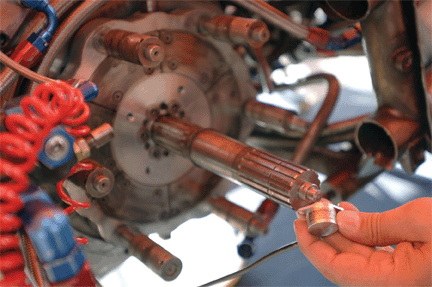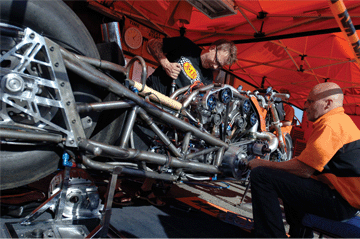In motor racing terms, it doesn’t get much simpler — traverse the straight line from A to B as quickly as possible. Within a split second, the engine of a 360 kg motorcycle screams to 7,500 rpm. Before a spectator has a chance to comprehend what has transpired, the race is over and bike and rider are a quarter mile down the track, braking frantically. Built by Finland-based Salakazi Racing and generating almost 1500 horsepower from just 1995cc, the KTM nitro methane dragster does the quarter mile in 6.7 seconds at a terminal velocity of 196 mph/316 km/h. Helping to barely tame the dragster’s controlled explosion are a brace of “bomb proof” Renishaw RM22 compact, high-speed rotary magnetic encoders.
Jaska Salakari – the first Finn to break the seven-second barrier for the quarter mile piloting the fastest Super Twin Top Fuel bike in the European Union – owns Salakazi Racing. Since 2000 his speed-obsessed six-man team, a combination of full- and part-timers, has been running a KTM Super twin powered dragster of its own design and construction. The 1995cc twin-cylinder Nitroduke engine is fueled with 95% nitro methane, gulping 1.1 litres per second of the volatile mix through a Salakazi-designed double fuel pump. It’s about as close to a flying bomb as any earthbound vehicle could get.

The KTM dragster, built by Salakazi Racing, makes fast, programmed take-off to burn the quarter mile in 6.7 seconds at 196 mph.
Getting the power down
In drag racing, reaction times are measured in milliseconds and races are never won with a wildly spinning rear wheel. All the horsepower in the world is useless unless effectively translated into rapid forward motion. For the pilot there’s little or no time to think, let alone engage and slip a normal clutch. It is impossible for the rider to accurately determine the rate of engagement needed to provide optimal traction.
Salakazi Racing has equipped its KTM dragster with an automatic Prowork three-disc, four-stage clutch fitted with a Prowork digital controller. When the rider snaps open the throttle, the pre-programmed controller engages the clutch. Then, the RM22 encoders, with their ability to monitor up to 30,000 rpm, go to work. One of the tiny but critical devices monitors the position of the crankshaft in the engine, while the other measures the clutch speed.
By comparing these values, the dragster team can precisely determine clutch slippage, traction and road conditions. This highly coveted data allows the technicians to properly adjust the first-stage counterweights in the clutch before the race.
Of course, track and bike conditions vary for every meeting, but the vital data collected and compiled by the encoder after every run makes it possible to program the controller for as close to optimum clutch engagement as possible. This provides maximum speed and acceleration with minimal wheel spin during the first few fractions of a second.
Petri Mäkinen, Salakazi Racing’s self-confessed “technology guru” points out that the encoder-based system is not the same as a traction control system. The clutch is tuned by set values programmed into the controller before the race against the clock even begins.
“The encoder isn’t interactively controlling the clutch while underway,” he explains, “but the data it provides us beforehand is critically important. We couldn’t obtain it – and couldn’t preset the clutch–any other way. We need to read the clutch speed even before the rear tire completes the first full rotation to make decisions for engaging the clutch, and the acceleration doesn’t happen smoothly. This problem has now been solved and proper filtration has been done to the program code.”
Mäkinen uses the data to put the maximum engine power on the road and propel Salakari to speeds in excess of 300 km/h in less time than it takes to read this sentence.

Compact, high-speed Renishaw encoder mounts on clutch shaft; another fits on end of the crank shaft.
Petri Mäkinen, Salakazi engineer,
integrated data-capturing Renishaw encoders into the KTM dragster to
optimize take-off traction. Next he wants to apply the compact
magnetic encoders to ignition advance and cam adjustment.
Exploding limits
The RM22 encoder handles harsh environments, but the Salakazi Racing Team has chosen one of the toughest of places to locate any piece of electronic equipment.
Pointing to the end of the crankshaft on a partially disassembled engine Mäkinen smiles mischievously and says, “This is where we put the magnetic actuator. We’ve located it directly on the end of the shaft. The encoder body is on the other side, in the clutch housing. I honestly think that only a space rocket would be a tougher environment for the encoder.”
The RM22 is designed and manufactured by Renishaw’s Slovenia-based partner company, RLS d.o.o., for high reliability in demanding applications and extreme environments. As a non-contact design — basically a magnet and a sensing chip — the robust, solid-state encoders have a small actuator magnet that fits to the end of a shaft, while the Hall sensor ASIC chip is epoxy-embedded and encapsulated inside a metal housing/mount. Fully sealed to IP68, the encapsulated design resists shock, vibration and acceleration-deceleration forces.
While maximum operating temperature is specified as 125ºC, the RM22 encoder still survives the very high temperature inside the clutch. The secret, says Mäkinen, is placing the encoder in the heavy, machined aluminum clutch housing and removing it fast.
“With a diameter of only 22 mm it was possible to locate the encoder in the clutch housing itself, without compromising the strength of the piece. Clutches can explode,” he says, as an aside. “I’ve seen this happen a few times, so the clutch housing plays an important role in rider safety. If the encoder were bigger we’d have to re-engineer the solution,” he notes.
“The heavy aluminum body shields the encoder from the heat during the race,” says Mäkinen. “After each race our mechanics cool the clutch and quickly remove the housing and the encoder. Before it ever gets a chance to heat up beyond specs, we’ve already got it back to the pit garage and removed it.”
The RM22’s non-contact, two-part design eliminates bearings or seals, allowing for rapid, easy installation and removal.
“Given the conditions, the reliability of the Renishaw encoders is amazing,” says Mäkinen. “Next season, these encoders will also be used to control the ignition advance and, in a couple of years, we are going to use the encoders to adjust cams. Without them, we could do nothing more than estimate vital engine and track information. But guessing isn’t good enough if you want to break records.”

Preparing the KTM dragster for the next race, encoder feedback allows the crew to program
for optimum performance before every run.
Mighty mite magnetic encoders
Essentially
just a magnet and a chip, the Renishaw magnetic encoders bring
wear-free non-contact design, low-inertia operation, and space-saving
miniaturization to problem conditions and harsh operating
environments. Available in 7-bit to 13-bit models and
industry-standard absolute, incremental or linear output formats, these
encoders deliver high-resolution positioning up to 8,192 count per
revolution, speeds to over 30,000 rpm, measurement accuracies to 0.4°,
while withstanding temperatures from -40°C to +125°C as well as high
levels of shock, vibration, acceleration, and pressure.
Easy to integrate, these encoders come in component, modular and
packaged versions. Their miniature size requires a fraction of the
area for optical encoders, solving tight packaging situations.
Engineers who require the smallest possible encoder can incorporate
encoder components or modular solutions into their design. Packaged
versions are available in non-contact (RM) or traditional bearing/shaft
formats (RE). Compact sealed versions are available with protection to
IP68 for harsh environments, including immersion applications, such as
in pumps and gearboxes.
At the heart of every Renishaw magnetic rotary encoder are two core
components — a small diametrically polarized magnet and a custom Hall
sensor ASIC that contains an array of Hall effect sensors that generate
a voltage when exposed to a magnetic flux field. The ASIC detects the
change in magnetic flux as the magnet rotates above it. The ASIC is
able to cancel magnetic interference, enabling it to operate in areas
of high external magnetic fields and cope with imperfections in the
shape of the flux field of the actuating magnet.
These mini mag encoders have been adopted for motor feedback,
industrial automation positioning, automotive steer-by-wire systems,
off-road vehicles, mobility devices, avionics control, missile and
munition guidance control, marine instrumentation, medical scanners,
agricultural, elevators, construction and lift equipment, converting,
printing, metalworking, CCTV, valve position control, vending machines,
and industrial power tools.
Renishaw
www.renishaw.com
:: Design World ::
Filed Under: Encoders • linear, Encoders • optical, Off highway • construction • agriculture, Encoders (rotary) + resolvers, SENSORS





Tell Us What You Think!